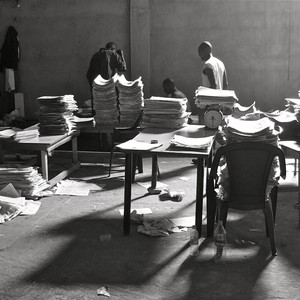‘It’s hard to sustain a newspaper in South Sudan’
Q: How are media houses doing financially?
A: They are not doing very well. This year alone we started the year off with probably about 15 newspapers. Even the advertisers did not know which papers to advertise in. By the end of the year we have maybe five newspapers [remaining in circulation]. And most of the time a newspaper stops for three months or one month and then again you see it.
Q: That’s a very high mortality rate. Why are newspapers dying so fast?
A: First, as the literacy level is very low, the readership is low. It is very hard to sustain a newspaper through readership because the printing costs are very high. Secondly, because the circulation is low, the newspapers here have less bargaining power with advertisers. And that means that advertisers who want to advertise are willing to pay the minimum. So in the end you cannot sustain a paper because you cannot pay the reporters so well and so they will end up in the NGO or private sector. So you end up in a cycle. You see no escape from this kind of crisis. But the hope is that as fewer and fewer papers remain on the market, the power to bargain [with advertisers] will increase.
Q: What characteristics will allow a newspaper to survive?
A: How they manage their resources is critical and how they can maintain circulation. You cannot put the advertisers first and the readers next because later, ultimately, the advertisers can shift to any other paper but the readers never shift. So the trick in the market is to grow a certain readership. You say this is our market [and] this is what we are going to target. Even if they are only ten thousands let us target them. And once you get those, then you can expand to other market segments. Then there you can start growing slowly if you wish but you know you are now sustainable. But it takes a while to get to that point.
Q: What is the time line? How long do you think it will take some of the papers to break-even?
A: I presume for a weekly it will take a lot longer, probably three or four years. People forget about weeklies: By the time you arrive [on the street] they see you and then they forget you a little bit and [when you publish the next issue] they come back to you. For a daily, the time frame is better but the printing costs are so high. And you cannot pass over these costs to the reader. You tell readers that the paper is three pounds [and] they say no. You tell [the advertisers] that the advertising [cost] per page is 5,000 pounds they and say no. They don’t want the quality they just want something to be in the paper. And that’s the market we are dealing with.
Q: If there were many companies would it be easier for newspapers to find advertisers?
A: If there were more companies then there would be more competition. The corporate sector right now is a monopoly for most of the sector. If you are talking about banks you know who is there and if you are talking about telecommunications you know who is involved. At least you can see a little bit of competition in the telecommunications sector because the companies that are here are all big and so they don’t think any one of them is going to die away very soon. So they have to keep on doing everything [to promote themselves]. They look at the newspapers, the radios, road shows [to advertise their services]. They don’t want to leave room for someone to come and take over their market. Some sectors, like banking, has one institution that is bigger and another one close behind. But you see [even in the banking sector] there is not really much competition. But in about a year or a year and a half, if the economy picks up, then more companies will move in. If we see more corporate actors, the newspapers will have a bigger revenue base.
Q: There have been complaints about some advertisers not paying up -- especially government. What is your experience?
A: With the government sometimes it’s about the budget. Sometimes procurement is done and there is no funding for what is being procured. I think it is more to do with the institution’s own internal policies and how they follow these policies on how they do procurement and less to do with whether government will pay or not. If the advert has actually gone through the procurement process there are no problems. So it also means that the media has to become a bit more responsible, [every media house] has to have its own policy of which advert it should take in: Has it gone through the procurement process?
Q: Is the survival rate the same for newspapers and radio stations?
A: I think for radio the rate of survival is determined by the same factors but the difference is that a radio station is very cheap to run. All you need is to run a generator daily and probably you use 400 pounds per day to run that generator. I have seen radio stations that don’t have staff. May be they have one person doing the marketing and playing music. So the actual overhead [costs] of running a radio station are much lower than for a newspaper. So radio survival rates are much higher. It is rare for a radio station to collapse. I have not seen a radio station that has gone down. People, don’t listen to them, people don’t advertise with them but they still survive.





